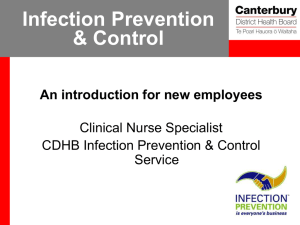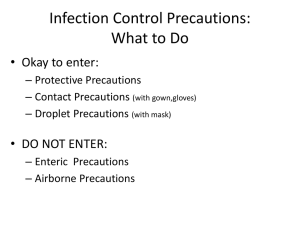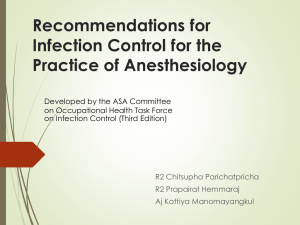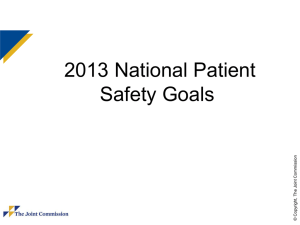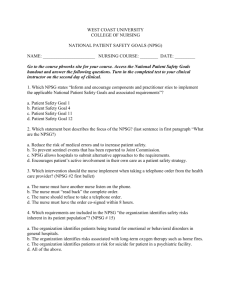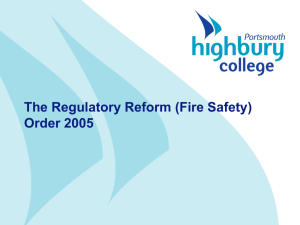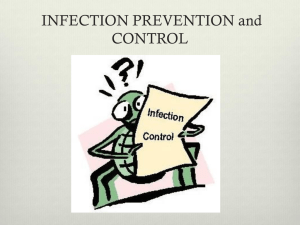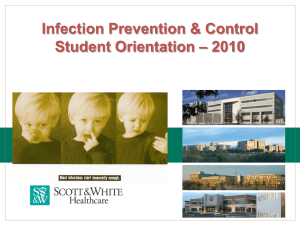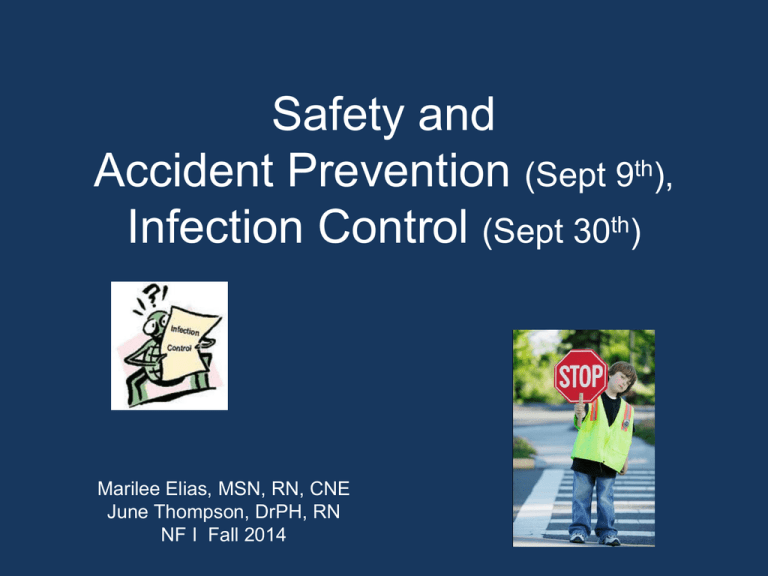
Safety and
Accident Prevention (Sept 9th),
Infection Control (Sept 30th)
Marilee Elias, MSN, RN, CNE
June Thompson, DrPH, RN
NF I Fall 2014
True or False
There is no such thing as an accident?
Accident Definition:
Chance, fortune, luck
Act of God
An unfortunate event
Injury Epidemiological Model
Host
Environment
•
•
Agent (energy)
• Mechanical
• Chemical
Social
Physical
The key to prevention
Unit Outcomes
1. Identify factors that influence accident/injury prevention.
2. Discuss implementation of the National Patient Safety
Goals
3. Identify methods to protect clients from injury.
4. Describe safe use of equipment
5. Use clinical decision making/critical thinking when using
restraint /safety devices.
6. Identify methods to maintain a safe environment
Safety is a Basic Human Need
NCLEX Test Plan 2013
Safe and Effective Care Environment
• „Safety and Infection Control 9-15%
• „Reduction of Risk Potential 9-15%
Safety/Accident Prevention
Injury Prevention
• Host factors Affecting Safety
– Age
– Individual Risk Factors
•
•
•
•
•
•
Lifestyle
Cognitive Awareness
Sensory/Perceptual Alterations
Impaired Mobility
Physical & Emotional Status
Safety Awareness
What’s age got to do with it?
• Safety concerns across the lifespan
– Children
– Adolescents
– Adulthood
– Older Adult
Children: Why are they
susceptible to Injury?
• Infants/Toddlers
• Preschooler
• School-age
Young Children (<1-4)
Leading Causes of
Unintentional Injury Deaths
United States - 2011
Centers for Disease Control
And Prevention
National Center for Injury
Prevention and Control
School age Children (5-9)
Leading Causes of
Unintentional Injury Deaths
United States - 2011
Centers for Disease Control
And Prevention
National Center for Injury
Prevention and Control
Adolescents
• Look! Up in the air! It’s a “Super Teen”!
• Judgment lags behind Strength & Confidence
• Drugs & ETOH = More risk with any activity
Adolescent/Young Adult (10-
Leading Causes of
Unintentional Injury Deaths
United States - 2011
Centers for Disease Control
And Prevention
National Center for Injury
Prevention and Control
Adult & Older Adult
• Adult
– Workplace injuries
– Drugs & ETOH
– Physical Activity =
• The “Weekend Athlete”
• Older Adult
– Physiological Changes
– Balance
– Sensory changes
Risk of Injury
Adults (25-54)
Leading Causes of
Unintentional Injury Deaths
United States - 2011
Centers for Disease Control
And Prevention
National Center for Injury
Prevention and Control
Older Adults (65 +)
Leading Causes of
Unintentional Injury Deaths
United States - 2011
Centers for Disease Control
And Prevention
National Center for Injury
Prevention and Control
In Summary Total
Leading Causes of
Unintentional Injury Deaths
United States - 2011
Centers for Disease Control
And Prevention
National Center for Injury
Prevention and Control
Let’s talk About Lifestyle
Is this
• Host
• Agent
• Environment
• None of the above
Safety & Injury Prevention Risk
Modifiable vs. Non-modifiable
Modifiable: Those things that may be changed or modified
Non-modifiable: Those things that may not be changed or modified
Why is it important to know the difference?
Adults: Let’s talk about
Lifestyles
• Smoking
• ETOH
• Drugs
– Rx and/or Illegal
• Risk-taking Behaviors
– Automobiles
– Employment
– Recreation/ Sports
Modifiable or Non-modifiable?
Sensory/Perceptual Alterations
• Changes or Loss of First Line Defenses
– Vision
– Hearing
– Smell
– Taste
– Sensation (think Diabetic Neuropathy)
– Can also relate to Cognitive Impairment
Modifiable or Non-modifiable?
Mobility
• Changes in:
– Strength
– Mobility
– Balance
– Endurance
• Use of Assistive Devices
Modifiable or
Nonmodifiable?
Injury Epidemiological Model
Host
Environment
•
•
Agent (energy)
• Mechanical
• Chemical
Social
Physical
The key to prevention
There’s been an Incident!
What Happens in Healthcare?
Types of Event
– Host / Client Behavior: Behavior precipitates incident
• Falls
• Agitation/ Aggression
– Agent / Therapeutic Procedures: Occurs during
delivery of medical or nursing interventions
• Radiation
• Chemotherapy
– Environment / Equipment:
• Failure
• Improper Use
• Not engaging safety features
Leading causes of medical
errors in hospitals
)
(Becker’s Infection Control & Clinical Quality, Hospital Review, Jan 2014
1.
Adverse drug events (medication errors)
2.
Catheter- associated urinary tract infection
3.
Central line- associated bloodstream infection
4.
Injury from falls and immobility
5.
Obstetrical adverse events
6.
Pressure ulcers (bed sores)
7.
Surgical site infections
8.
Venous thrombosis (blood clots)
9.
Ventilator- associated pneumonia
Let’s talk Prevention!
Assess & Reduce Risks in All Environments
• Home
–
–
–
–
–
–
–
–
Poisonings
CO Poisoning
Scalds & Burns
Fires
Environment
•
Social
•
Physical
Firearm Injury
Suffocation/Asphyxiation
Take-Home Toxins
Home Safety Assessment Scale (SAS)
(vol.2 p.376)
- Falls
- Choking (let’s rescue)
Host
Agent (energy)
•
Mechanical
•
Chemical
• Community
Host
– MVCs
– Pathogens
• Food-Borne
• Vector-Borne
• Water-Borne
– Pollution
•
•
•
•
Air
Water
Noise
Soil
– Mother Nature
Environment
•
•
Social
Physical
Agent (energy)
•
Mechanical
•
Chemical
• Healthcare Facilities
Medication Errors
Never Events
Falls
• Risk Assessments (Morse Fall Scale) & Fall Prevention
Equipment-Related Injuries
Fires
• R.A.C.E.
Electrical Hazards
Restraints
• Mechanical and/or Chemical
Host
• Proper Use & Patient Care
• Siderails
• Patient Alarm Devices
Environment
•
•
Social
Physical
Agent (energy)
•
Mechanical
•
Chemical
• More Healthcare Facilities…
Environment
Mercury Exposure
•
Social
•
Physical
Biological Hazards
Hazards to Healthcare Workers
Needlestick Injury
Back Injury
Radiation Injury
Violence (Who’s at risk for violent behavior?)
Host
Agent (energy)
•
Mechanical
•
Chemical
Safe Use of Equipment
•
•
•
•
•
•
Proper Training
When in doubt, ASK!
Lock those Wheels
Inspect and Observe Equipment
Report Problems & Remove Equipment
Facility Policies about Patients bringing Electrical
Host
Devices from Home
Environment
•
•
Social
Physical
Agent (energy)
•
Mechanical
•
Chemical
Now there’s been an Incident!
• Incident Reports
–
–
–
–
–
–
–
What are they?
What do we report?
Won’t they just get someone in trouble?
Won’t my peers think I’m a snitch?
Won’t it make a big deal out of nothing?
Isn’t it just more paperwork?
What’s the Result of Incident Reports?
Why learn about safety ?
• Estimated 440,000 Americans die annually
from preventable hospital errors.
• This makes hospital errors the 3rd leading
cause of death in the U.S.*
• Annual cost to society is over $17.1 billion
annually **
• Hospital Safety Score, Washington, Oct. 2013
• National Institutes of Health, Millwood, Oct 2011
Two initiatives focused on
Safety
1. Quality and Safety Education for Nurses
[QSEN]
2. National Patient Safety Goals
[NPSG]
Quality and Safety Education for Nurses Project
(QSEN)
• Prepare future nurses with the knowledge, skills
and attitudes (KSAs) to improve the quality and
safety of healthcare systems
• Defines competencies and proposed targets for
the knowledge, skills and attitudes (KSAs) to be
developed in nursing pre-licensure programs
QSEN 6 Competencies
•
•
•
•
•
•
Patient Centered Care
Teamwork and Collaboration
Evidence Based Practice
Quality Improvement
SAFETY
Informatics
www.qsen.org
Promoting Patient Safety
• National Patient Safety Goals (NPSG) brought to
us by:
• The Joint Commission (TJC)
– Formerly known as the Joint Commission for
Accreditation of Healthcare Organizations (JCAHO)
NPSG Purpose
• The purpose of the Joint Commission’s National Patient
Safety Goals is to promote specific improvements in
patient safety
• The requirements highlight problematic areas in health
care and describe evidence and expert-based solutions
to these problems
• The requirements focus on system-wide solutions,
wherever possible
The NPSG Safety Goals Project
We will focus on:
• Goal1: Patient Identification (NPSG.01.01.01)
• Goal 2: Improve Staff Communication (NPSG.02.03.01)
• Goal 3: Use Medications Safely- Labeling
(NPSG.03.04.01)
• Goal 3: Use Medications Safely- Passing on Info
(NPSG.03.06.01)
• Goal 7: Prevent Infections- Hand Washing
(NPSG.07.01.01)
• Goal 7: Prevent Infections- Catheters (NPSG.07.06.01)
2014 National Patient Safety Goals
1. NPSG.01.01.01 Use at least 2 patient identifiers when providing
care, treatment, and services.
2. NPSG.02.03.01 Report critical results of tests and diagnostic
procedures on a timely basis.
3. NPSG.03.04.01 Label all medications, medication containers, and
other solutions on and off the sterile field in perioperative and other
procedural settings (includes syringes, medicine cups and basins).
4. NPSG.03.06.01 Maintain and communicate accurate patient
medication information.
5. NPSG.07.01.01 Comply with either the CDC or WHO hand hygiene
guidelines.
6. NPSG.07.06.01 Implement evidence-based practices to prevent
indwelling catheter-associated urinary tract infections (CAUTI).
QSEN vs. NPSG
QSEN-Broader Categories
NPSG-More Specific Situations
Patient Centered Care
Identify Patients Correctly
Teamwork and Collaboration
Improve Staff Communication
Evidence-Based Practice
Use Medications Safely- Labeling
Quality Improvement
Use Medications Safely- Passing on
Information
Safety
Prevent Infections- Hand washing
Informatics
Prevent Infections- Catheters
High Alert Medications
• What’s a high alert medication?
• Do medication worksheets for:
– Digoxin (Lanoxin)
– Warfarin (Coumadin)
• NPSG 03.05.02 Take extra care with patients who
take medicines to thin their blood
Tall Man Lettering
FDA and ISMP 2014
Thinking and Teaching about
Safety
• You are making a home health nurse visit to Teresa, her 2 year old
child and her elderly grandmother who is recovering from a hip
fracture. They live in a rural area and Teresa is the primary
caregiver for both of them. Teresa’s husband is a long-distance
truck driver and is often away for a week at a time.
How is Safety Assessed in
Acute Care Settings?
•
•
•
•
•
Morse fall risk scale
Braden scale
Sleep apnea scale
Medications
Basic Nursing Care
What do you know?
• Teresa tells you that the toddler is very active
and getting “into everything”
• Teresa tells you that since her grandmother was
discharged from the rehabilitation center she
has been very afraid of falling and does not want
to do anything for herself
What’s a nurse to do?
• Why are Teresa’s child and grandmother at risk
for injuries?
• What will you look for as you assess the family’s
home environment?
• What interventions will you suggest to Teresa to
improve home safety for her and her family?
Safety Project
Instructions and Group
Assignments
Infection Control
th
Tuesday, Sept 30
Unit Outcomes
•
•
•
Describe methods to control the spread of
infectious agents.
Identify methods to control or eliminate infectious
agents.
Use clinical decision making/critical thinking to
ensure standard/transmission based/other
precautions.
Infection Control
Chain of Infection
• Handwashing
Defense Mechanisms
Types of Infectious Responses
Stages of Infection
Nosocomial Infections
• Handwashing
Medical & Surgical Asepsis
• Handwashing
Standard & Isolation Precautions
• Handwashing
Chain of Infection
What Mechanisms Defend the
Body against Infections?
• Primary Defenses
– What has the Body got going for itself?
• Secondary Defenses
– How does the Body respond to invaders?
• Tertiary Defenses
– Specific Immunity
• Humoral Immunity
– Non-specific Immunity
• Cell-mediated Immunity
Classifying Infections
• Local vs. Systemic
– Types of infectious responses
• Bacteremia vs. Septicemia
• Primary vs. Secondary
• Acute vs. Chronic vs. Latent
Nosocomial Infections
• Where and How do patients get them?
– Exogenous Nosocomial Infections
– Endogenous Nosocomial Infections
• Why does Healthcare care?
– Patient Outcomes
– $$$$$$$$$$$$$$
Stages of Infection
• Incubation
– Time between invasion and symptoms
• Prodromal Stage
– Vague symptoms
• Illness
– Signs and Symptoms appear
Stages of Infection
• Decline
– Time period when body defenses and
treatments are working
• Convalescence
– Return to health
– Can last for long periods of time
Who cares about DrugResistant Pathogens?
• MRSA
• VRE
• Clostridium difficile (AKA C. difficile)
– Why is C. diff so DIFFICULT?
What factors increase the
susceptibility of a Host?
•
•
•
•
•
•
•
•
•
Developmental stage
Breaks in the first line of defense
Illness or Injury
Tobacco Use/ Substance Use
Multiple Sex Partners
Environmental Factors
Chronic Disease
Medications
Nursing & Medical Procedures
Let’s Defend Host Defenses
(Promoting wellness)
•
•
•
•
•
•
Good Nutrition
Good Hygiene
Rest & Sleep
Exercise & Activity
Stress Reduction
Immunizations (herd immunity?)
Medical & Surgical Asepsis
• Medical Asepsis
– A state of cleanliness
• Environment
• Disinfection vs. Sterilization
– Hands
• What do we do?
Hand Wash vs. Hand Rub?
(WHO 2009)
• When to hand wash?
• How to hand wash?
• When to hand rub?
• How to hand rub?
CDC
2014
Handwash
Handrub
CDC
2014
More food for Handwashing Thoughts
• Things my hands did today:
• Showered me, fed me, brushed my teeth, dressed my body,
scratched the dog, drove me to LSSC, scratched my nose, shook
hands with my friends, picked up the pen I dropped on the floor in
the bathroom, touched door handles, took books off the library
shelves, handed my cell phone to my friend (who still has a cold),
took the phone back and used it to call home, rubbed my eyes, got a
Kleenex from my friend (who still has a cold), fed me lunch, opened
a door for a guy having a sneezing fit, drove me home, fed me
dinner, turned pages while I studied, brushed my teeth, and pulled
back the covers on the bed…
• I wonder what was on all those things I touched?
With all we do & touch, how Long can
Viruses live outside of the body?
• Influenza Virus
– 72 HRS on Nonporous Surface
– 48 HRS on Plastic, Magazines
– 24 HRS on Pajamas
• Bird Flu
– 144 HRS on all tested surfaces
• RSV Respiratory Syncytial Virus
– 8 HRS on Nonporous Surfaces
– 2.5 HRS on Cloth
• Rhinovirus-the common cold
– 15-85 HRS on Nonporous Surfaces
• Blood Borne Viruses- HIV, HBV
– 7 Days or more
Ebola Virus
Hemorrhagic Virus
When an infection does occur in humans, the virus can be
spread in several ways to others. The virus is spread through
direct contact (through broken skin or mucous membranes)
a sick person's blood or body fluids (urine, saliva, feces,
vomit, and semen)
objects (such as needles) that have been contaminated with
infected body fluids infected animals
Personal Protective Equipment
“Standard Precautions”
1.
2.
3.
4.
Gown
Mask or Respirator
Goggles or Face Shield
Gloves
1. Gown
2. Mask or Respirator
3. Goggles or Face Shield
4. Gloves
Surgical Asepsis
•
•
•
•
•
Sterile
Surgery
Doing the “Surgical Scrub”
Surgical Attire
Sterile Technique
Sterile Fields
Finding the Isolation
Precautions in SimChart
• Order entry
• General Orders
Infection Protection for All
CDC & two tiers of protection
• Standard Precautions
– (Tier One, aka Universal Precautions)
• Transmission-Based Precautions (Tier Two)
–
–
–
–
Contact Precautions
Droplet Precautions
Airborne Precautions
Protective (or Reverse) Isolation
Tier 2 Precautions
Contact Precautions
• Contact precautions are used
when a person has a type of
bacteria or virus on the skin or
in a sore, or elsewhere in the
body such as the intestine, that
can be transmitted to someone
else if the person touches the
infected individual or
contaminated surfaces.
Staphylococcus aureus (MRSA),
Salmonella, Clostridium difficile
Tier 2 Precautions
Droplet Precautions
• Use droplet precautions
whenever you are in a room
with a patient who is infected
with a virus or bacterium that
is transmissible via the
droplets of mucus and
saliva. These droplets are
generated when a patient
coughs, sneezes, or talks
Tier 2 Precautions
Airborn Precautions
• Airborn transmition
occurs by
• Airborne droplets
containing the
microorganisms that
remain suspended in
the air for long
periods of time
• Dust particles that
contain an infectious
agent
Tier 2 Precautions
• Protective or Reverse Isolation
Who is the patient?


